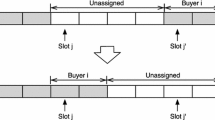Abstract
We study the following TV ad placement problem: \(m\) identical time-slots are on sale within a period of \(m\) days and only one time-slot is available each day. Advertisers arrive and depart online to bid for some time-slots to publish their ads. Typically, advertiser \(i\) arrives at the \(a_i\)’th day and wishes that her ad would be published for at most \(s_i\) days before she departs. The goal is to maximize the social welfare which is the sum of values of the published ads. In this paper, we design a competitive online mechanism in which each advertiser is motivated to report her private value truthfully and can learn her payment at the very moment that she wins some time-slots. When all demands \(s_i\)’s are uniform, we prove that our mechanism achieves a non-trivial competitive ratio of \(5\). We also study general cases and derive upper and lower bounds.
Similar content being viewed by others
Notes
In the whole paper, we consider the scenario that each advertiser is only interested in publishing her ad on some consecutive days. Note that even if advertisers can publish ads on days which are not consecutive, our prompt mechanism still works and has the same competitive ratio; but our lower bound on the competitive ratio does not hold in such model.
To utilize time-slots efficiently, any rational publisher will not allocate advertiser \(i\) more than \(s_i\) time-slots.
When \(m\) is not a multiple of \(s\), introduce some dummy slots which will not be used by any advertiser.
Group \(G_j\) is totally included in time window \(W_i=[a_i,d_i]\) if and only if \(a_i \le (j-1)\cdot s+1\) and \(d_i \ge j\cdot s\).
This is because \(i\) can win one group when bidding \(v_i\) and \(p\) is the least value \(i\) can bid to win one group.
References
Aggarwal G, Goel G, Karande C, Mehta A (2011) Online vertex-weighted bipartite matching and single-bid budgeted allocations. In Proceedings of the twenty-second annual ACM-SIAM symposium on discrete algorithms, SIAM 1253–1264
Aggarwal G, Hartline J (2006) Knapsack auctions. In: Proceedings of the seventeenth annual ACM-SIAM symposium on Discrete algorithm, ACM, 1083–1092
Archer A, Tardos É (2001) Truthful mechanisms for one-parameter agents. In Foundations of Computer Science, Proceedings. 42nd IEEE Symposium on, IEEE, 482–491
Azar Y, Khaitsin E (2011) Prompt mechanism for ad placement over time. Algorithmic Game Theory 6982:19–30
Bartal Y, Chin F, Chrobak M, Fung S, Jawor W, Lavi R, Sgall J, Tichỳ T (2004) Online competitive algorithms for maximizing weighted throughput of unit jobs. STACS 2996:187–198
Borgs C, Chayes J, Etesami O, Immorlica N, Jain K, Mahdian M (2007) Dynamics of bid optimization in online advertisement auctions. In Proceedings of the 16th international conference on World Wide Web, ACM, 531–540
Bu T-M, Deng X, Qi Q (2012) Multi-bidding strategy in sponsored search auctions. J Comb Optim 23(3):356–372
Chan W, Lam T, Ting H, Wong P (2004) New results on on-demand broadcasting with deadline via job scheduling with cancellation. Comput Comb 3106:210–218
Chin F, Fung S (2003) Online scheduling with partial job values: does timesharing or randomization help? Algorithmica 37(3):149–164
Chrobak M, Jawor W, Sgall J, Tichỳ T (2004) Improved online algorithms for buffer management in qos switches. Algorithms-ESA 3221:204–215
Cole R, Dobzinski S, Fleischer L (2008) Prompt mechanisms for online auctions. Algorithmic Game Theory 4997:170–181
Dósa G, Epstein L (2010) Online scheduling with a buffer on related machines. J comb optim 20(2):161–179
Edelman B, Ostrovsky M, Schwarz M (2007) Internet advertising and the generalized second-price auction: selling billions of dollars worth of keywords. Am Econ Rev 97(1):242–259
Englert M, Westermann M (2007) Considering suppressed packets improves buffer management in qos switches. In Proceedings of the eighteenth annual ACM-SIAM symposium on Discrete algorithms, Society for Industrial and Applied Mathematics, 209–218
Li R, Yang L, He X, Chen Q, Cheng X (2011) Semi-online scheduling for jobs with release times. J Comb Optim, 1–17
Nisan N, Bayer J, Chandra D, Franji T, Gardner R, Matias Y, Rhodes N, Seltzer M, Tom D, Varian H et al (2009) Google’s auction for tv ads. Autom, Lang Program, 309–327
Ting H (2006) A near optimal scheduler for on-demand data broadcasts. Algorithms Complex 3998:163–174
Ting H, Xiang X (2012) Equilibria of gsp for range auction. In: Gudmundsson J, Mestre J, Viglas A (eds) Computing and combinatorics. Springer, New York, pp 580–591
Vickrey W (1961) Counterspeculation, auctions, and competitive sealed tenders. J Financ 16(1):8–37
Zhou Y, Chakrabarty D, Lukose R (2008) Budget constrained bidding in keyword auctions and online knapsack problems. Internet Netw Econ 5385:566–576
Author information
Authors and Affiliations
Corresponding author
Additional information
A preliminary version appeared in COCOA’2013.
Rights and permissions
About this article
Cite this article
Xiang, X. Prompt mechanism for online auctions with multi-unit demands. J Comb Optim 30, 335–346 (2015). https://doi.org/10.1007/s10878-014-9754-9
Published:
Issue Date:
DOI: https://doi.org/10.1007/s10878-014-9754-9




